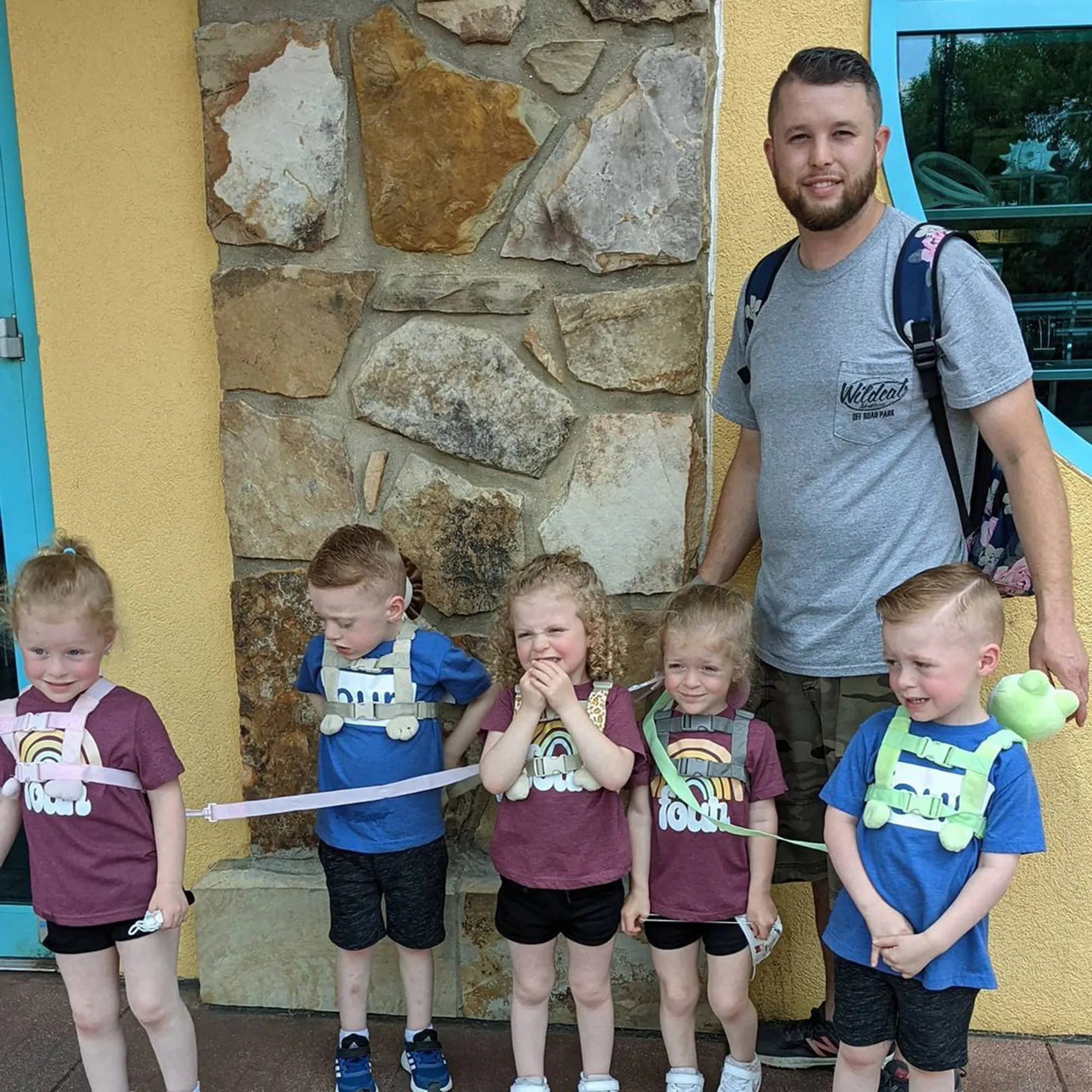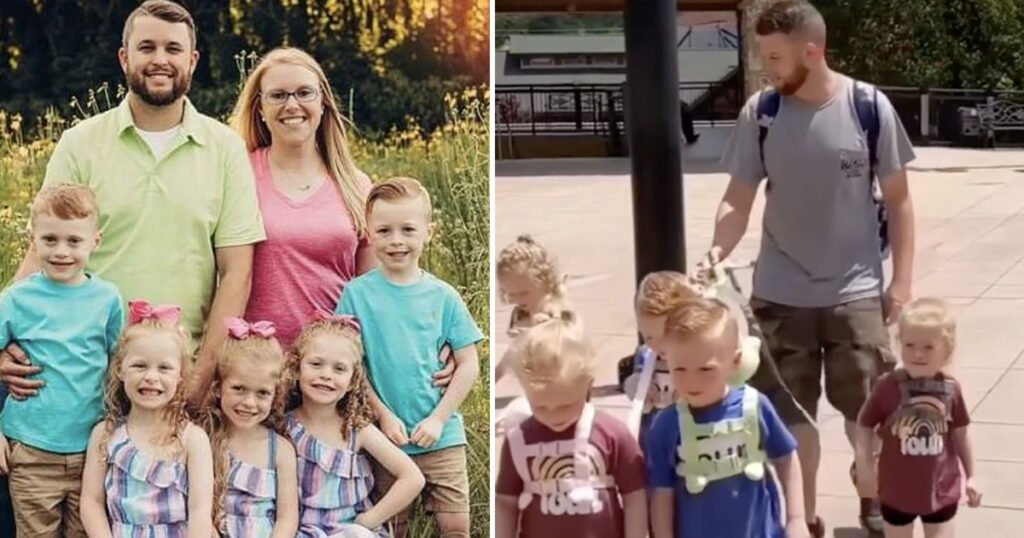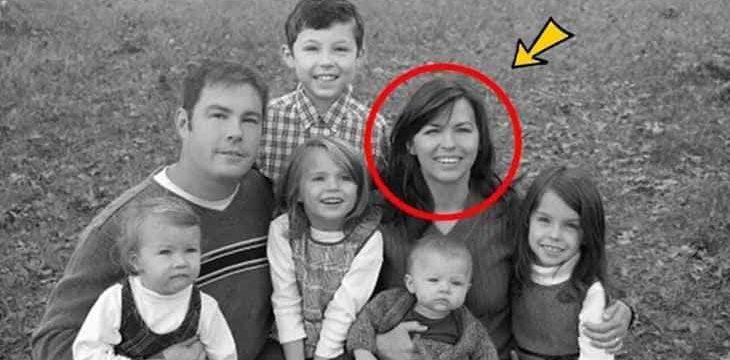
Raising children in today’s world is already a challenging task. Add in unsolicited opinions from family members and strangers on the internet, and parenting can feel overwhelming. For young parents like Jordan Driskell, navigating the complexities of raising kids has become a balancing act that’s as exhausting as it is rewarding. Jordan’s story, however, sheds light on the unique struggles and creative solutions that come with parenting quintuplets.
Jordan Driskell, a 31-year-old father from Kentucky, has his hands full—quite literally. He is the proud parent of five quintuplets, all five years old. As you might imagine, caring for five children of the same age is no small feat. At five, children are naturally curious and eager to explore the world around them, which can quickly become a handful for any parent, let alone one managing quintuplets.
To address the challenges of keeping all five children safe and under control in public spaces, Jordan came up with an innovative solution: child leashes. While the concept of child leashes has sparked debate for years, Jordan decided this was the most practical option for his family.
From Stroller to Leashes: A Necessary Transition
Initially, the Driskells relied on a six-seater stroller to transport their quintuplets. While practical for a time, the stroller soon became a logistical nightmare. The kids would grow restless, and maneuvering the bulky stroller through crowded spaces was no easy task. It also limited the children’s ability to move and explore their surroundings, which Jordan recognized was important for their development.

The leashes, however, offered a new kind of freedom. Each child could safely walk, explore, and experience the world, all while staying within arm’s reach of their father. For Jordan, this solution wasn’t about control but rather safety and peace of mind. It allowed him to manage his energetic children in public without compromising their ability to explore.
A Viral Controversy
Jordan’s innovative parenting choice didn’t go unnoticed. After sharing a video of the family’s outing to an aquarium on social media, it quickly went viral, amassing over three million views. In the video, the quintuplets are seen happily exploring their surroundings, tethered to their leashes. While many praised Jordan for his creative solution, others were quick to criticize.
Some detractors compared the leashes to treating children like animals. Comments flooded in, with remarks like, “Don’t have so many kids if you can’t handle them” and, “Can’t you just train your children properly? Teach them not to run off.” These criticisms were often cloaked in judgment, suggesting that leashes were a failure of parenting rather than a practical tool.
Expert Support for Jordan’s Approach
Not everyone saw the leashes as a problem. Parenting and adolescent development specialist Dr. Deborah Gilboa came to Jordan’s defense, arguing that child leashes are a practical tool, particularly for families with younger children or those with neurodiverse needs. Dr. Gilboa emphasized that safety should always take precedence and noted that using a leash doesn’t dehumanize children or reduce them to pets.
“A leash is an excellent tool for keeping young or neurodiverse kids safe in public spaces,” Dr. Gilboa explained. However, she added that for neurotypical children, it’s important for parents to gradually transition away from leashes as kids develop listening and communication skills. By the time a child is eight or nine, verbal communication should ideally replace the need for tools like leashes.
The Reality of Parenting Without Judgment
Jordan’s story highlights a broader issue faced by parents today: the relentless social scrutiny of their choices. Whether it’s debates about breastfeeding, screen time, or child leashes, parents are often bombarded with unsolicited advice and criticism. Yet, the truth is that no one-size-fits-all approach exists in parenting. Every child, family, and situation is unique.
For Jordan, the leashes are a temporary but necessary measure to ensure the safety and happiness of his quintuplets. As he balances the demands of parenting five energetic kids, he remains focused on what works best for his family—regardless of outside opinions.
What Do You Think?
The debate over child leashes is far from settled. While some view them as restrictive, others see them as a practical tool for ensuring safety. Ultimately, parenting is about making choices that prioritize a child’s well-being while allowing them the freedom to grow and explore.
What’s your take on the use of child leashes in public? Do you think they’re a practical solution or an unnecessary measure? Let us know your thoughts in the comments below, and don’t forget to share this article with friends and family to hear their opinions too!
By fostering conversations around parenting styles, we can move toward a more understanding and supportive community for all families.





